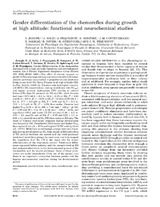Mostrar el registro sencillo del ítem
Gender differentiation of the chemoreflex during growth at high altitude : functional and nerurochemical studies
| dc.contributor.author | Joseph, V | |
| dc.contributor.author | Soliz, J | |
| dc.contributor.author | Pequignot, J | |
| dc.contributor.author | Sempore, B | |
| dc.contributor.author | Cottet-Emard, JM | |
| dc.contributor.author | Dalmaz, Y | |
| dc.contributor.author | Favier, R | |
| dc.contributor.author | Spielvogel, Hilde | |
| dc.contributor.author | Pequignot, JM | |
| dc.date.accessioned | 2017-03-06T18:30:22Z | |
| dc.date.available | 2017-03-06T18:30:22Z | |
| dc.date.issued | 2000 | |
| dc.identifier.uri | http://repositorio.umsa.bo/xmlui/handle/123456789/9783 | |
| dc.description.abstract | The effect of chronic hypoxia on gender differences in physiology and neurochemistry of chemosensory pathways was studied in prepubertal and adult rats living at sea level (SL; Lyon, France) or at high altitude (HA; La Paz, Bolivia, 3,600 m). HA adult rats had higher hematocrit (Ht%), Hb concentration, resting ventilatory rate (Ve100), and higher tyrosine hydroxylase (TH) activity in carotid bodies (CB) than SL animals. At HA and SL, adult females had lower Ht% (46.0 +- 0.8 vs. 50.4 +- 0.6% at HA, P < 0.05 and 43.8 +- 0.9 vs. 47.1 +- 0.8% at SL, P < 0.05) and Hb (16.1 +- 0.3 vs. 17.7 +- 0.2 g/dl at HA, P < 0.05 and 14.5 +- 0.3 vs. 15.6 +- 0.1 g/dl at SL, P < 0.05) than males. Females had higher Ve100 [170 +- 19 vs. 109 +- 7 ml·min-1·100 g-1 at HA, P < 0.05 and 50 +- 3 vs. 40 +- 2 ml·min-1·100 g-1 at SL, not significant (NS)] and lower CB-TH activity (1.40 6 0.2 vs. 3.87 +- 0.6 pmol/20 min at HA, P < 0.05 and 0.52 +- 0.1 vs. 0.68 +-6 0.1 pmol/20 min at SL; NS) than males at HA only. The onset of hypoxic ventilatory response during development was delayed at HA. Prepubertal HA females had higher Ve100 than males (2 wk old, 147%) and higher CB-TH activity (3 wk old, +51%). Medullary noradrenergic groups were sex dimorphic during development at SL. Rats raised at HA had a drop of TH activity between the second and the third postnatal week in all medullary groups. In conclusion, our data support the hypothesis that the CB is the major site for sexual differentiation of the ventilatory control. Ventilatory differences appeared before puberty, and the animals bred at HA had profound alterations in the developmental process of the chemoreflex and its neural pathways. Some of these alterations are under dependence of the sex of the animal, and there is an important interaction between gender and the hypoxic environmental condition during the developmental period. | es_ES |
| dc.language.iso | en | es_ES |
| dc.publisher | Am J Physiol Regulatory Integrative Comp Physiol | es_ES |
| dc.subject | DESARROLLO | es_ES |
| dc.subject | CUERPOS CAROTÍDEOS | es_ES |
| dc.subject | NEURONAS NORADRENÉRGICAS | es_ES |
| dc.title | Gender differentiation of the chemoreflex during growth at high altitude : functional and nerurochemical studies | es_ES |
| dc.type | Article | es_ES |

